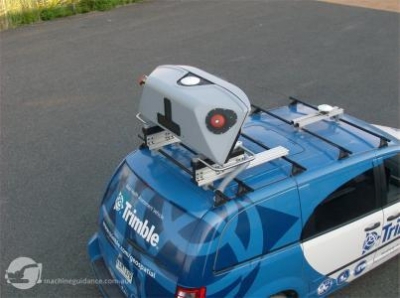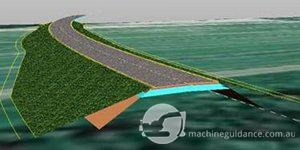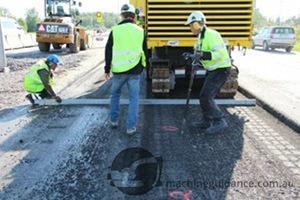Spatial Imaging for Machine Control Models
Contractor successfully utilises spatial imaging systems to accelerate the complete construction phase - from 3D road scanning & modelling to 3D machine-guided milling.Published: March 2014
Author: Trimble Heavy Construction Division

1
Destia Ltd is a leading motorway contractor and consultant in Finland. With some 1600 employees, the company builds and maintains traffic and industrial environments with expertise and experience in a range of construction services as well as planning and design services and surveying.Â
As a leader in the industry, Destia is taking steps to develop a framework for model-based design and construction. Destia believes that by using more accurate models for building and reconstruct projects, contractors can greatly improve quality and project productivity. The model based process spans the complete construction lifecycle from the design (pre-model) to project management (model based production control and guidance) and the production phase, which includes machine control, surveying, quality control, and implementation.
Since 2007, 3D machine control systems have been used in more than 100 Destia projects. The company has more than 60 excavators, bulldozers, wheel loaders, motor graders and drill rigs equipped with 3D control systems.Â
During the spring of 2012, the company determined it would use these new modeling and machine automation techniques on a road project commissioned by the Finish Road Administration. Road 51 is a main thoroughfare from the nation's capital, Helsinki, to the west. The design, build, and maintenance involved 10 kilometers of motorway, 10 bridges and three interchanges. Basic design and reconstruction included turning the old two-lane road into a four-lane highway as well as performing milling and paving.Â
In May 2012, Destia ordered ground radar and took core road samples of Road 51. This data was used to verify the pavement thickness and was used for the design process. Three continuous Ground Penetrating Radar (GPR) profiles measured along the road. The team found that the pavement thickness varied greatly from 10 centimeters to 24 centimeters. In some deflection areas, pavement surface thickness reached even 90 centimeters. This benchmarking was critical because the milling crew did not want to risk breaking the pavement below the reconstruct zone because of the high costs associated with repaving.Â
When it came time to survey, collecting data presented a few distinct challenges. One is that Road 51 has heavy traffic and is consistently busy which put surveyor safety at an extremely high risk and was a significant concern. In addition, the project had strict accuracy requirements of 15 millimeters in height for the reconstructed road.Â
With this challenge at hand, Destia chose to abandon manual survey techniques and adopt a spatial imaging data capture system. This test project was made possible through a partnership with Infra FINBIM consortium, a Finnish organization focused on technology and building information modeling. Field data was then collected with Trimble MX8, a mobile mapping and data capture system. The Trimble MX8 Mobile Spatial Imaging System combines imaging and laser scanning capabilities to measure objects in 3D data sets for spatial imaging projects.

2
In short, the pod-like MX8 system can be installed on a variety of vehicles and, once configured, it uses advanced GNSS plus inertial position to collect 3D data accurately, even while travelling at highway speeds. The system simultaneously collects laser point clouds and digital images. Signal point measurements are gathered with Trimble Total Station or GNSS and precise levelling. Trimble Trident-3D Analyst software allowed for fast and robust analysis and interpretation of the field data.
"We selected the MX8 imaging and laser scanning system and SPS930 total station because we wanted improved safety for our surveyors our short project time frame, and our high accuracy requirements of 15 millimeters," said Mika Jaakola, Development Manager at Destia. "As a result of using it, we were able to reduce the total project time and we had more detailed and accurate data for planning, which is a priority for mass optimization across the project."
With accurate survey and data sets collected, the information was transferred to a sophisticated LiDAR and image data processing software package called Terrasolid. After point processing was complete, the model showed 3D lines and included contours of the road and break lines. Model based-vertical alignments, geometries and the payment surface were then designed and optimized using Tekla Civil software. Georeferenced imagery and laser scanned data captured from the road with Trimble MX8 was then used to optimize the design. Milling and filling areas were visualized by surface difference maps. As a result, vertical main points were adjusted in a delicate manner. More importantly, cross sections and longitudinal sections were used to visualize the difference between pavement and cutting surfaces. Using these methods, Road 51 was measured and modeled and a repair plan was developed in one month, which beat expectations by several weeks.
Mass quantities were then calculated using designed layers, which were then exported into the Trimble data preparation tool Trimble Business Center - HCE to create a surface model. The machine control model could then be recognized by the Trimble GCS900 Grade Control System. Local Trimble HCC dealer at that time, Geotrim Ltd. completed the machine control integration on the Wirtgen W2100 milling machine owned and operated by NCC Roads Ltd. in a single day- including calibrations and measure ups-following the intuitive interface and 'plug and play' nature of the system.

3
Communicating with the total station, the GCS900 machine control system was able to show a model that included the surface, alignment and break lines; mill/fill areas were shown as design maps. These maps and models were then transferred to the milling machine and were viewed by operators using a CB460 control box. The automatic 3D systems display design information and live mill/fill indications. The system then provides real-time information for monitoring avoidance zones as the machine mills to that specific depth. Janne Paitsola from the local Trimble HCC Dealer strongly believes 3D milling is the future, is absolutely more accurate than traditional milling, and is ideal for complex surfaces, such as super elevations, transitions, and changing slopes.
Mika Jaakola was extremely pleased with the results achieved from 3D machine control. He attributes the success of the project to having a design of pavement repair based on a more accurate surface model and the machine control itself.
"In my opinion, a well-planned job is already half done," said Jaakola. "Not only is the lead time shortened because road repair actions and quantities can be planned for, this method of modeling and 3D milling makes us more competitive because it saves materials and hauling time."
Spare
4
Even despite heavy rain early on in the project, work was completed in a short four month window. Altogether, the Destia team and subcontractor NCC Roads Ltd. completed 15,000 square meters of milling and they met, and actually beat, the rather strict surface requirements. Crews were able to reach mill speeds of more than 10 meters per minute.Â
"The irregular surfaces that we faced made it all but impossible to manage and control the appropriate elevation with traditional milling practices," said Jaakola. "With the 3D milling method you always have the accurate model as the background, which gives you a lot smoother surface a lot more quickly."Â
Jaakola believes 3D machine control systems in milling machines allowed for improved work quality, with greater efficiency and accuracy. He believes it also served to increase profit margins because designers, as well as building crews, can be more productive.
Credit Source
Trimble applies technology to make field and mobile workers in businesses and government significantly more productive. Solutions are focused on applications requiring position or location-including surveying, construction, agriculture, fleet and asset management, public safety and mapping. Read more about Trimble Heavy Construction at www.trimble-productivity.com.
Return to Articles

